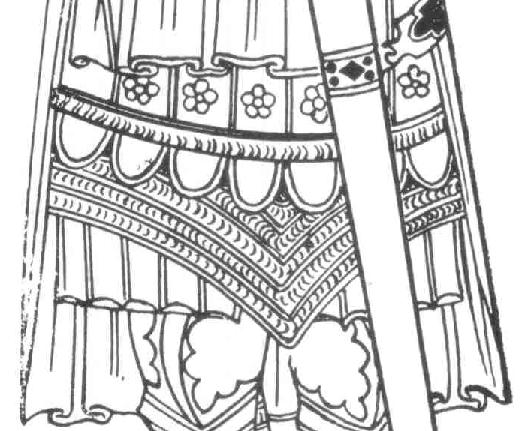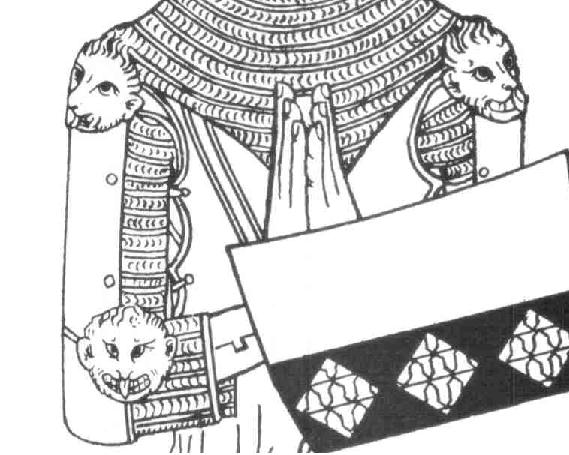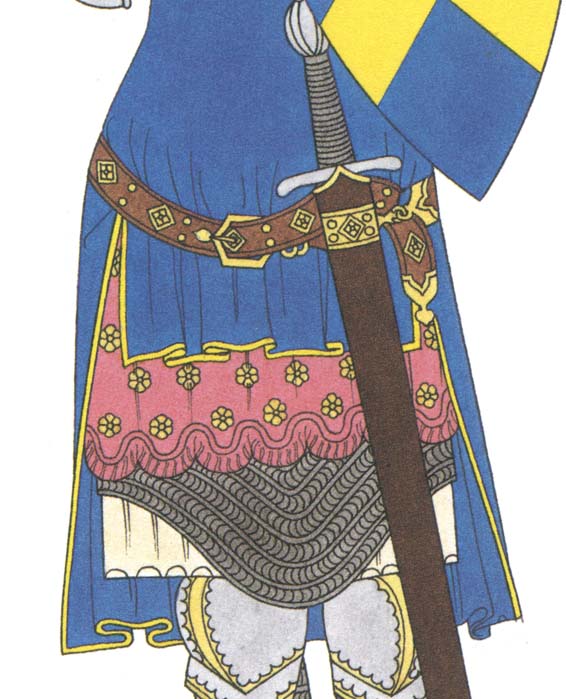| Author |
Message |
Richard Fay

|
 Posted: Sun 15 Oct, 2006 8:07 am Post subject: Studded Armour Posted: Sun 15 Oct, 2006 8:07 am Post subject: Studded Armour |
 |
|
Hello all!
I've split this off the "cuir boulli quandary" thread, since I think it deserves a discussion of its own.
| Dan Howard wrote: |
Current thinking is that "studded leather" is a misinterpretation of brigandine illustrations. Studded armour did not exist historically. Practical experimentation suports this. Adding metal studs to leather or quilted cloth provides virtually no additional protection against any of the weapons faced on a medieval battlefield.
|
Dan,
I must disagree with your position regarding studded armour. There are a few examples of Chinese cloth armour that possess studs but no underlying plates. One of about 1840 is shown in a photo in George Cameron Stone's massive glossary of arms and armour. Granted, it's probably more ceremonial than practical, being armour of the officers of the Imperial Guard. Another is shown in Stephen Turnbull's An Historical Guide to Arms and Armour. This one from the Kienlung Period of 1736-95 has a few plates on the shoulders and chest, but the majority of the protection is provided by quilted fabric peppered with round studs.
Here are the actual descriptions of the Chinese studded cloth "armours" straight from my sources:
| George Cameron Stone wrote: |
Chinese armour of officers of the Imperial Palace Guard. About 1840. Gold brocade embroidered in colours and edged with black velvet. Gilt rivet heads but no plates. The shoulder pieces are gilded dragons. The helmet is plain steel with gilded ornaments. |
(From A Glossary of the Construction, Decoration, and Use of Arms and Armour in all Countries and in all Times.)
I agree that the one in Stone seems to be purely a ceremonial, decorative garment. It is shown next to a more proper Chinese "brigandine", another Imperial Palace Guard Officer's armour with small plates held beneath the fabric by rivets. The next example, however, may serve some protective function.
| Stephen Turnbull wrote: |
Quilted Chinese armour of the Kienlung Period, 1736-95. Here quilted fabric is the main form of protection; plates appear only on the shoulder and in the helmet. The helmet itself has a quilted lining and the metal parts are decorated with dragons soaring in clouds (The Field Museum, Chicago).
|
(From An Historical Guide to Arms & Armor)
Note that this second garment is quilted, which would offer a light protection like an ordinary gambeson. I'm not saying their is a direct evolutionary link between the Chinese "studded quilted armours" (if there was one, I assume there were others) and the garments on the early 14th century English brasses, but I'm utilizing the same notion that anthropologists use when they study modern "Stone Age" peoples to get an idea about how prehistoric "Stone Age" peoples lived.
I agree that this "studded quilted armour" must provide minimal protection at best, and many claims of medieval studded armour are misinterpretations of brigandine, but these studded cloth Chinese armours bear a striking resemblance to some of the torso protection worn over the hauberk on some of the early 14th century English brasses.
Some of the older authors (like Charles Henry Ashdown and Charles ffoulkes) used to call these garments of the "cyclas period" "gambesons" or "upper pourpoints". They used to think that these represented padded garments, not early coats-of-plates, but recent authors have rejected this notion. After taking a close look at quality illustrations and reproductions of some of these brasses (like the pictures in Henry Trivick's The Picture Book of Brasses in Gilt and the drawings in Charles Henry Ashdown's European Arms and Armor), I'm not sure the idea should be so easily discarded. (By the way, the Trivick book took almost all the images "off the top of the brass" originals and then reproduced these in positive "gilt and black". And, yes, this book shows all three brasses I refer to.)
Take a close look at the brasses of Sir John D'Aubernoun the Younger of 1327 or Sir John De Creke of 1325. Both wear a studded garment beneath the "cyclas" and over the hauberk. Both garments show lines similar to the quilting lines on the gambesons or aketons underneath the mail. These possible (probable?) "stitching lines" are carved as double-lines, very similar to the way the stitching is shown on the gambesons or aketons depicted on even earlier brasses, like those of Sir William fitz Ralph and Sir William de Setvans. The lines can be seen at the armpit on each, and in each case it curves to follow the curve of the body. Also, there appear to be no studs in the armpit area. The hem line on these garments also seems awfully low for a coat-of-plates. Furthermore, the D'Aubernoun brass shows rivets or studs along the lines as well as down the middle of the rows, a strange configuration if the "studs' were holding plates beneath the fabric. Finally, the brass of Sir John de Northwood may show the garment worn beneath the mail, although the lower half is a palimpset and may be an inaccurate restoration.
Later brasses such as the lost brass of Sir Miles de Stapleton, from an impression in the British Museum, show armour that more clearly represents a coat-of-plates or early brigandine. There are no "stitching" lines, and the rivets are lined up in nice neat rows.
Apparently, English armour of the early 14th century was known as being old-fashioned. In Armies and Warfare in the Middle Ages: the English Experience by Michael Prestwich, the author states that Jean le Bel had commented on how old-fashioned English armour was compared to that on the continent. Gambesons were worn over mail occasionally in the 13th century; a few soldiers in the Maciejowski Bible are so equipped. Perhaps the D'Abernoun the Younger and the De Creke brasses show a late survival of this sort of thing. Even if these garments are a sort of gambeson rather than a coat-of-plates, the "studs" may be more decorative than protective. Again remember that these brasses are from a time of experimentation in armour; even if they are "studded cloth", the concept didn't last long!
Now "stud and splint" or just "splinted" armour, armour made from leather (or perhaps cloth) reinforced with strips of metal, sometimes accompanied with "studs" or "disks" was widely used in Germany and sometimes elsewhere. Look at the effigy of Kaiser Gunther of Schwarzburg, for instance. The arms and legs are protected with mail supplemented with armour of leather (cloth?) reinforced with strips and disks. It was perhaps a "cheap" or "light" alternative to full plate. Or, could it be the Germans just thought it looked "mean"? (Line drawings of many of these effigies can be seen in J.H. Hefner-Alteneck's Medieval Arms and Armor: a Pictorial Archive. I've seen photos of some in other sources that closely match the drawings, so I have no reason to believe that the drawings are inaccurate.)
Of course, I agree with you that the typical "studded leather" armour so popular in role playing games was never used, as far as we know, as a torso defence!
I wish I could post the images of the brasses or the Chinese armours; perhaps someone else can!
I hope you found this of interest!
Stay safe!
"I'm going to do what the warriors of old did! I'm going to recite poetry!"
Prince Andrew of Armar
|
|
 |
 |
Richard Fay

|
 Posted: Sun 15 Oct, 2006 8:59 am Post subject: Posted: Sun 15 Oct, 2006 8:59 am Post subject: |
 |
|
Hello again!
Here's more information regarding "studded quilted armour" (or, more specifically, the use of padded garments over mail) that I split off the "cuir boulli quandary" thread. I've also added a bit more. Enjoy!
I remembered another thing I read that led me to believe that the "studded" garment on the early 14th century English brasses may be a type of gambeson instead of a coat-of-plates. Mention is made in both Tournaments by Richard Barber and Juliet Barker and Warrior 18: Knight of Outremer 1187-1344 AD by David Nicolle of an early fourteenth century armorial treatise that describes how a knight should arm for combat and the tournament. The two books differ slightly in their interpretation; Nicolle says the knight preparing for the joust puts on an aketon, hauberk, and gambeson faced with fine silk, then plates or cuirass, shield, bascinet, and great helm. The book by Barber and Barker says that the knight preparing for the joust must put on his aketon, hauberk, and gambeson, the last a quilted surcoat made of precious cloth, then steel plates, a shield, a bascinet, and helm complete the outfit.
Here's the actual excerpt from Nicolle:
| David Nicolle wrote: |
Descriptions from the 14th century are more varied, with for example, slight differences when preparing for a tournament or a battle. In both cases a brazier was supposedly lit and a carpet laid before the knight stripped to his shirt and combed his hair. For a tournament he put on leather shoes or leggings. Over these came plates of steel or cuir bouilli to protect his thighs, knees and calves. Next came the quilted aketon then a mail hauberk and coif; a cuirass or unspecified form of "leather hauberk", a surcoat with the knight's coat-of-arms, and his whalebone gauntlets. Lastly he put on his sword-belt and helmet. For war, an iron plates de alemayne cuirass and gorgieres neck defences were added, while for jousting an aketon, hauberk and gambeson with a fine outer layer of best silk, plus steel plates or cuirass, shield, bascinet and great helm were advised. |
(From Warrior 18: Knight of Outremer 1187-1344 AD)
And here's the actual excerpt from Barber and Barker:
| Richard Barber and Juliet Barker wrote: |
An early fourteenth century armorial treatise gives a useful summary of what the well-dressed knight of the period would have worn for combat (from a manuscript in the British Library). The Latin treatise on how to arm a knight differentiates between the costume for tournaments, for war and for jousts. First of all a fire should be lit, a carpet laid out and the knight should strip to his shirt and comb his hair. For tournaments he should put on leather shoes and leggings over which plates of steel or cuir bouilli should be placed to protect the thighs, calves, and knees. Next came his aketon, a quilted coat worn under the armour, over which would be worn a mail shirt and a coif (camissa de Chartres, coyfe de Chartres) and, as a final outer layer of protection, a leather hauberk (?) or cuirass. A surcoat of some kind, carrying his armorial bearings, would then be placed over all the functional armour, and the knight could put on his whalebone gauntlets. His costume was completed by his sword, whip, and helm. For war, the knight wore virtually the same armour, with only German steel plates (plates de alemayne) and a good throat defence (gorgeres) being specifically singled out for special mention. The main diffreence appears to have been the weapons which were to include the sword, axe, and dagger; a note is made that the shield is rarely carried in war because it impedes more than it assists. For jousts, the author suggests an aketon, hauberk and gambeson, the last being a quilted surcoat made of precious cloth, preferably silk. Steel plates, a shield, a bascinet and a helm completed the outfit. |
(From Tournaments. The italics are the authors', not my own. )
Compare this description to the D'Abernoun the Younger and De Creke brasses. If Nicolle was wrong about interpreting "steel plates" as a cuirass or coat-of-plates, then perhaps this was referring to the greaves and vambrace. Barber and Barker don't specify what "steel plates" meant. It could mean "pair-of-plates", "coat-of-plates", or "cuirass", but it could refer to the tubular steel defences for the limbs. Why insist that the outer gambeson should be made of precious cloth, preferably silk, if it was hidden beneath other garments? I know the hem may show anyway, but this description sounds remarkably similar to the harness depicted on the early 14th century brasses. Of course, "plates" could be referring to an early breastplate hidden beneath the surcoat on the brasses. Still, the garments seen descending below the hem of the shortened surcoat appear padded, not necessarily plated.
I know the treatise definitely mentions the addition of "plates de alemayne" (coat-of-plates, literally "German plates") and a "gorgeres" (gorget) as additions for war. The aketon-hauberk-gambeson combination was more for the joust (I assume the "joust of peace"), but perhaps old-fashioned English knights sometimes wore lighter, outdated armour. It fits with what Jean le Bel said about English equipment of the early 14th century.
I have one more bit of information I would like to add to my argument that the garments seen descending below the hem of the surcoat on the D'Abernoun and De Creke brasses are padded, possibly with studs, instead of coat-of-plates. Some 14th century Welsh effigies depict knights in "old-fashioned", even "primitive armour. There is one in the parish church in Llanarmon that shows a padded gambeson worn over mail. The garment looks remarkable like the garment worn by D'Aubernoun and De Creke , minus the studs. Very often, "backwards" or "poorer" areas made due with older styles of armour; just like Jean le Bel's description of English armour as being "old fashioned" as compared to that used on the continent.
A photo of this effigy appears in David Nicolle's Campaign 138: Poitiers 1356: the Capture of a King . Here's what he says in the caption:
| David Nicolle wrote: |
Troops recruited in north Wales and the neighbouring English county of Cheshire played a significant part in the 1355 and 1356 campaigns, including the battle of Poitiers. The majority were archers, but local men-at-arms and knights would have taken part. The old-fashioned and in some respects primitive styles of armour used by even the military elite of north Wales can be seen in some knightly effigies from these regions. Here, for example, the recumbent knight has a thickly quilted gambeson over a mail hauberk, a separate mail colliere and a simple cerveliere helmet. (In situ parish church, Llanarmon) |
There are a few oddities depicted in this effigy; he seems to wear padded gauntlets (not completely odd in and of itself), but the shield looks like it bears quilting lines as well! It might just be a depiction of the knight's coat-of-arms in three dimensions; they did that occasionally on the effigies. Still, the padded garment worn over the mail looks reasonable enough.
All this, the Chinese armours, the armorial treatise, and the Welsh effigy, have led me to rethink the assessment of the garment shown over the hauberk and beneath the surcoat on the D'Aubernoun and De Creke brasses. This could be a representation of "studded and padded" garments, perhaps an early 14th century experiment.
Okay, I think I've said enough about this issue for the moment!
Hope someone finds this of interest!
Stay safe!
"I'm going to do what the warriors of old did! I'm going to recite poetry!"
Prince Andrew of Armar
|
|
 |
 |
Dan Howard

|
 Posted: Sun 15 Oct, 2006 3:05 pm Post subject: Posted: Sun 15 Oct, 2006 3:05 pm Post subject: |
 |
|
The Chinese examples are "faux brigandine." It was never intended to be worn as armour. It was probably never worn outside an Asian court. Brigs were extremely fashionable both in Asia and in Western Europe. These things were simply an imitation of this armour without the metal plates underneath. de Commynes talks about similar clothing in Europe. He thought it strange that the two gentlemen in question were wearing it on a campaign march since they had real armour to wear when they reached the battle site.
The European examples are gamboised cuisses. The only time "studs" were added was when metal was added for reinforcing. When splints were added underneath, only the rivets are viible on the surface. They can't be classed as "studded armour" any more than a brigandine can be classed as "studded armour"
|
|
  |
 |
Richard Fay

|
 Posted: Sun 15 Oct, 2006 8:18 pm Post subject: Posted: Sun 15 Oct, 2006 8:18 pm Post subject: |
 |
|
Hello all!
| Dan Howard wrote: |
The European examples are gamboised cuisses. The only time "studs" were added was when metal was added for reinforcing. When splints were added underneath, only the rivets are viible on the surface. They can't be classed as "studded armour" any more than a brigandine can be classed as "studded armour"
|
Dan,
A rose by any other name,
would it smell so sweet?
(Sorry, but I couldn't resist quoting, or perhaps misquoting, the Bard!)
I am aware that knights sometimes wore gamboised cuisses in the 13th and 14th centuries. If you took a look at the "studded and splinted" thread already, you already know that I said I even made some replicas out of cheap cloth, to get an idea of the form they took. The Setvans and the Fitzralph brasses both show what appears to be a quilted garment worn on the thigh above the knee. It is hard to see, but it just peeks out from beneath the gambeson (or aketon). However, that is not what I was referring to in this thread!
If you take a close look at the De Creke and the D'Abernoun the Younger brasses, what at first might appear to look like a coat-of-plates begins to look odd. Keep in mind, these are definitely worn on the torso; these aren't the cuisses I'm referring to. In both brasses, the garments appear to have quilting lines just like the gambesons worn beneath the hauberks, and just like the gambeson in the earlier Setvans and Fitzralph brasses. What may at first appear to be rivets holding plates beneath a cloth (or perhaps leather, in some instances) cover begin to look wrong on the D'Abernoun the Younger brass. The rivets or studs appear between the "quilting" lines, but also along the lines themselves. If this held plates, and the lines (vertical only, not horizontal) represented the edges of the plates, then the rivets must go through the space between the plates as well as the plates themselves. It seems to be a rather impossible configuration, don't you agree? However, if the rivets or studs were attached by themselves to the fabric, then it would make more sense.
If you read my previous post all the way through (I know I tend to go on, but I have a lot to say about the matter), then you read that I agree the studs would offer little to no protective advantage. However, what if they were meant to be mostly decorative? Sometimes things were done purely for decorative reasons; why elaborately tool a piece of leather for a rerebrace that might get all beat up if it was to see any real action? Why create fancy flower designs on poleyns that might function better if they were perfectly smooth?
Oh, I don't doubt that the Chinese armours were worn more as ceremonial garb, but I did find the fact that at least one was padded to be interesting. That's what led me to take another look at the early 14th century English brasses.
Of course, since what appear to be "studs" are in the shape of pretty flowers, maybe they weren't studs at all. Maybe the engravers were trying to depict an embroidered fabric. Still, the look of the garment on both the De Creke and D'Abernoun the Younger brasses bears a striking resemblance (once you ignore the differences in cut) to the Chinese "faux brigandines".
Quilted garments do offer some protection, correct? Quilted garments were worn over mail as well as under mail, don't you agree? Would you more readily accept my interpretation if I called the garments "decorated gambesons" instead of "studded armour"? (Which brings me back to the reason I quoted Shakespeare in the beginning.) 
I'm sorry if what I was talking about wasn't clear earlier. I wish I had the means to post pictures, but my scanner is the type that only takes single pages, and I don't want to destroy my books. Perhaps someone else could post some pictures of what I'm talking about.
At least give my idea some thought. Please!!!  
Stay safe!
"I'm going to do what the warriors of old did! I'm going to recite poetry!"
Prince Andrew of Armar
|
|
 |
 |
Dan Howard

|
 Posted: Mon 16 Oct, 2006 4:55 am Post subject: Posted: Mon 16 Oct, 2006 4:55 am Post subject: |
 |
|
|
Brigandines were often made with rivets arranged in patterns - including "flowers". Faux brigandines also made use of attractive rivet patterns without the metal plates underneath. The whole point of this fashion was to emulate the appearance of functional armour. If they offer no additional protection then they cannot be classified as "armour". I have no problem if you want to classify this as "decoration" and not a distinct type of armour.
|
|
  |
 |
Richard Fay

|
 Posted: Mon 16 Oct, 2006 7:41 am Post subject: Posted: Mon 16 Oct, 2006 7:41 am Post subject: |
 |
|
Hello all!
| Dan Howard wrote: |
Brigandines were often made with rivets arranged in patterns - including "flowers". Faux brigandines also made use of attractive rivet patterns without the metal plates underneath. The whole point of this fashion was to emulate the appearance of functional armour. If they offer no additional protection then they cannot be classified as "armour". I have no problem if you want to classify this as "decoration" and not a distinct type of armour. |
Dan,
Yes, I know the rivets on brigandine could be arranged in decorative patterns; I even used the same concept on a coat-of-plates in the novel that I wrote! I find the arrangement of the rivets in groups of threes delineating little triangles on the material especially pleasing to my artist's eyes; it has a sort of simple yet effectively decorative look about it! And I know the rivets could take decorative forms themselves. One of the coats-of-plates from Visby has copper mounts in the shapes of heraldic shields, fleur-de-lis, and scallop shells! That must have looked amazing during its working life, with the mounts gilt or enameled, and covered in a rich material!
I wasn't implying that the "studs" themselves were armour, just that there may have been a functional quilted garment with attached studs used in early 14th century England. Of course, the interpretation of the flowers as rivets may not even be accurate; it may just represent embroidery. Still, if the studs on the Chinese "faux brigandines" are meant to be decorative (no argument there, right?), then perhaps the flowers on the garment between the surcoat (sometimes, incorrectly I believe, called a cyclas) and the hauberk depicted on the De Creke and D'Aubernoun brasses are rivets or studs.
I used the term "studded armour" since it seemed convenient. Again, if you insist the name makes too many implications regarding the protective qualities of the "studs", then we can call it something else! It does seem to be all a matter of semantics, doesn't it?  
However, I do believe the garments on the English brasses were meant to be armour, in other words, protective garments. They do appear similar to the "aketons" worn beneath the hauberks, and I already pointed out the armorial treatise that describes the layering of aketon-hauberk-gambesons. Gambesons were protective garments, whether or not they were further decorated with "studs", embroidery, covered in a rich fabric, or otherwise "artistically enhanced".
Of course, using the term "studded armour" got your attention, didn't it?   
Stay safe!
Richard
"I'm going to do what the warriors of old did! I'm going to recite poetry!"
Prince Andrew of Armar
|
|
 |
 |
|
William Knight
Location: Mid atlantic, US Joined: 02 Oct 2005
Posts: 133
|
 Posted: Mon 16 Oct, 2006 8:15 am Post subject: Posted: Mon 16 Oct, 2006 8:15 am Post subject: |
 |
|
It's possible that on fabric armours the 'studs' were actually rivets that were holding different layers of fabric together. Now there's no direct evidence of this being done that I'm aware of, but there are pictures of jacks with rivets in them, and I've talked to people that theorize that rather than being rivets for reinforcing plates these were rivets that replaced stitching as a means of fasenting the different layers to each other.
Still, I wouldn't call them studs, since that seems to imply that their purpose was to be protruding metal things, not to act as fasteners.
-Wilhelm
|
|
  |
 |
Richard Fay

|
 Posted: Mon 16 Oct, 2006 9:30 am Post subject: Posted: Mon 16 Oct, 2006 9:30 am Post subject: |
 |
|
Hello all!
| William Knight wrote: |
It's possible that on fabric armours the 'studs' were actually rivets that were holding different layers of fabric together. Now there's no direct evidence of this being done that I'm aware of, but there are pictures of jacks with rivets in them, and I've talked to people that theorize that rather than being rivets for reinforcing plates these were rivets that replaced stitching as a means of fasenting the different layers to each other.
Still, I wouldn't call them studs, since that seems to imply that their purpose was to be protruding metal things, not to act as fasteners.
|
William,
That's an intriguing possibility, but I doubt that this is the case with the two English brasses. I don't think the "studs", "rivets", or whatever you may call them were necessary to hold these garments together. The garments definitely display double "quilting lines" just like the undisputed aketons (gambesons) worn beneath the hauberks. Trying to interpret the brasses with my "artist's eyes", I ask myself "why would the engraver depict the outer garment with lines similar to the quilting lines of the inner garment unless he was trying to depict quilting?". (I know medieval art can sometimes be unreliable, but the brasses of this period seem to lack any gross stylization, and seem very detailed in their depictions of the armour of the time.) If the roses depict some sort of metal attached to the fabric, it probably serves a more decorative rather than functional purpose. After all, the garments were obviously richly decorated; they both exhibit a decorative fringe around or just above the scalloped hem!
One other interesting detail about these brasses that I forgot to mention; there is one point of difference between the inner aketons and the outer gambesons. The inner aketons show definite "chords" along the hem, a clear depiction of their thickness. The outer gambesons lack this feature, implying that they were thinly padded as compared to the inner aketons. Perhaps they were just more thickly padded in the chest region than around the hem.
Interesting thought, though, William. Thanks for the input! I never knew my use of the word "studs" would produce such controversy!
Stay safe!
Richard
"I'm going to do what the warriors of old did! I'm going to recite poetry!"
Prince Andrew of Armar
|
|
 |
 |
Dan Howard

|
 Posted: Mon 16 Oct, 2006 2:24 pm Post subject: Posted: Mon 16 Oct, 2006 2:24 pm Post subject: |
 |
|
|
Some interesting points being raised. I'm not sure there is any point in further discussion until someone posts the relevant images.
|
|
  |
 |
Richard Fay

|
 Posted: Mon 16 Oct, 2006 5:35 pm Post subject: Posted: Mon 16 Oct, 2006 5:35 pm Post subject: |
 |
|
Hello all!
I hope this can add something to the discussion. I found an accurate representation of the De Creke brass in a Bellerophon Coloring Book. I know what you're saying, "a coloring book?", but I matched the image to the one in the Trivick book (the one that took the images right "off the top of the brasses"), and the Bellerophon drawing is a very accurate reproduction. I didn't want to cut up or otherwise damage any of my more expensive arms and armour books. Unfortunately, some of the finer details regarding the lines might not come out. Keep in mind, too, that the other brass, D'Abernoun the Younger, is the one with the "roses" (rivets?) along the "quilting" lines as well as between them.
One other thing, remember that authors in the early 20th century interpreted the garments between the hauberk and surcoat as padded garments. Charles Henry ashdown called them gambesons. Charles ffoulkes called them "upper pourpoints". Recent authors interpret these garments as coats-of-plates. I think this may need a reassessment, based on the details shown on the brasses, the fact that English armour of the early 14th century was considered to be "old-fashioned", the fact that at least one 14th century Welsh effigy in "old-fashioned" armour clearly wears a gambeson over his hauberk with no indication of plates, and that the early 14th century armorial treatise describes wearing an aketon-hauberk-gambeson combination for the joust.
Okay, here it is, the De Creke brass (if it's not clear, I will try to post a close-up of the hem area to more clearly show the "double lines"):
 Attachment: 29.57 KB Attachment: 29.57 KB

Sir John De Creke, 1325
"I'm going to do what the warriors of old did! I'm going to recite poetry!"
Prince Andrew of Armar
|
|
 |
 |
Richard Fay

|
 Posted: Mon 16 Oct, 2006 5:48 pm Post subject: Posted: Mon 16 Oct, 2006 5:48 pm Post subject: |
 |
|
Hello again!
Since I wasn't completely happy with how the details came out on the image of the whole brass, I thought I would post close-ups of the hem and shoulder. Note the double lines, just like on the aketon, on the outer garment. And, let me point out again, the details in the drawing are the same on the "gilt and black" version taken directly from the brass.
One other thing, if anyone can post an image of the D'Abernoun the Younger brass, it would be greatly appreciated! I have an image of that one in the Trivick book, but I would have to cut the page out to scan it. The possible rivets on the D"Aubernoun brass are in a strange configuration if they are meant to be holding plates!
I hope this clarifies things!
 Attachment: 49.64 KB Attachment: 49.64 KB

Detail of the hem from the De Creke brass.
 Attachment: 50.11 KB Attachment: 50.11 KB

Detail of the shoulder from the De Creke brass.
"I'm going to do what the warriors of old did! I'm going to recite poetry!"
Prince Andrew of Armar
|
|
 |
 |
Chad Arnow
myArmoury Team


|
 Posted: Mon 16 Oct, 2006 6:58 pm Post subject: Posted: Mon 16 Oct, 2006 6:58 pm Post subject: |
 |
|
| Richard Fay wrote: | One other thing, if anyone can post an image of the D'Abernoun the Younger brass, it would be greatly appreciated! I have an image of that one in the Trivick book, but I would have to cut the page out to scan it. The possible rivets on the D"Aubernoun brass are in a strange configuration if they are meant to be holding plates!
|
Here you go.
 Attachment: 34.25 KB Attachment: 34.25 KB

 Attachment: 73.98 KB Attachment: 73.98 KB


ChadA
http://chadarnow.com/
|
|
    |
 |
Richard Fay

|
 Posted: Mon 16 Oct, 2006 7:35 pm Post subject: Posted: Mon 16 Oct, 2006 7:35 pm Post subject: |
 |
|
Hello all!
Thanks, Chad!   
Not just any version, but the colour version from Arms and Armour of the Medieval Knight! (That's a book I know cover-to-cover!)
Note the "roses", coloured gold in the illustration. If they are rivets, then it would be a strange arrangement to have rivets between plates as well as in the middle of the plates (assuming the lines were meant to represent the edges of plates instead of quilting lines). Also note the lines in the reddish-coloured garment are doubled, just like the lines in the aketon or gambeson worn beneath the hauberk. It certainly appears as if the artist meant to depict a quilted garment rather than a coat-of-plates.
Thanks again, Chad!   
"I'm going to do what the warriors of old did! I'm going to recite poetry!"
Prince Andrew of Armar
|
|
 |
 |
Nick Trueman

|
 Posted: Wed 18 Oct, 2006 2:11 am Post subject: Posted: Wed 18 Oct, 2006 2:11 am Post subject: |
 |
|
Hi
Maybe a little bit off topic but I know of early Byzantine MS pics and artwork showing soldiers wearing gambessos/aketons wich appear to be studded? These studs have been interpreted as stitching forming a diamond pattern on the outer fabric. I think it is feasable to have studded padded armour without metal plates, as what we have found through reenactment ( new varangian guard) is that it compresses the inner filling/padding making it less cumbersome and thick.
Thanks
Nick
|
|
  |
 |
Hisham Gaballa

|
 Posted: Wed 18 Oct, 2006 3:49 am Post subject: Posted: Wed 18 Oct, 2006 3:49 am Post subject: |
 |
|
| Nick Trueman wrote: | Hi
Maybe a little bit off topic but I know of early Byzantine MS pics and artwork showing soldiers wearing gambessos/aketons wich appear to be studded? These studs have been interpreted as stitching forming a diamond pattern on the outer fabric. I think it is feasable to have studded padded armour without metal plates, as what we have found through reenactment ( new varangian guard) is that it compresses the inner filling/padding making it less cumbersome and thick.
Thanks
Nick |
This is even further of topic then.
In India from the late 16th to the early 19th centuries, a type of fabric armour called chihal'ta hazar masha ('coat of a thousand nails') was used. This consisted of a padded coat decorated with metal studs. However many examples of this armour are also reinforced with steel plates, like the examples in the Wallace Collection and the Royal Armouries in Leeds.
This are the ones from the RA, please click on the thumbnails:
    
This one is from the Museo Stibbert:

|
|
  |
 |
Jean Thibodeau

|
 Posted: Wed 18 Oct, 2006 6:45 am Post subject: Posted: Wed 18 Oct, 2006 6:45 am Post subject: |
 |
|
History aside, at least as far as Medieval Europe is concerned, and with only a design perspective, the density and size of studs or rivets or small disks should make some difference in cut resistance everything else being equal.
Rivets every 3" would do very little to improve the cut resistance of a leather or padded garment. At the other extreme rivets the size of a quarter place edge to edge would I think make a difference.
The amount of weight might make just using maille instead more practical and probably lighter.
Oh, with a protruding stud instead of a flatter rivet or disc there is the possibility that closely place studs would or could make a blade deflect away from the surface instead of digging into the fabric.
Anyway, between the two extremes in surface coverage I tend to think that metal reinforced soft armour would be more cut resistant: The amount of extra protection might be negligible or significant ?
Oh, one other point: A thick gambison might give equal protection to the wearer but a metal reinforced one might last longer and need less repair less often. The point of the reinforcements being more to protect the surface of the armour than protecting the wearer underneath. ( Just ideas I'm throwing out there as opinion and debating points for further discussion. )
You can easily give up your freedom. You have to fight hard to get it back!
|
|
  |
 |
Richard Fay

|
 Posted: Wed 18 Oct, 2006 8:16 am Post subject: Posted: Wed 18 Oct, 2006 8:16 am Post subject: |
 |
|
Hello all!
Thanks for the great replies, everyone. I don't think they are "off-topic", since I never specified medieval European "studded armour" when I started the topic. I certainly used the Chinese "studded armours" (or "faux brigandines") as part of my argument interpreting the garment shown on the early 14th century English brasses as "quilted and studded".   
| Nick Trueman wrote: |
Maybe a little bit off topic but I know of early Byzantine MS pics and artwork showing soldiers wearing gambessos/aketons wich appear to be studded? These studs have been interpreted as stitching forming a diamond pattern on the outer fabric. I think it is feasable to have studded padded armour without metal plates, as what we have found through reenactment ( new varangian guard) is that it compresses the inner filling/padding making it less cumbersome and thick.
|
Nick,
Not off topic at all! I believe we have to use armours from various time periods and places to interpret some of the more unusual medieval European armour. There could ultimately be a Byzantine or Near-Eastern influence behind these garments, or they could have evolved the same idea independently.
Your mention of the Byzantine gambesons caused me to recall a figure in the colour plates in Osprey's Armies of the Crusades by Terence Wise, colour plates by G.A. Embleton. It shows a Byzantine peltast of the early 12th century. The description says that peltasts were probably an economy measure, better armed than light infantry but not as heavily armed as the older heavy infantry. The description suggests that lack of funds would have led to the peltasts being clothed in quilted and studded armour instead of the earlier lamellar. The garment is quilted in diamonds, with metal studs in the centre of each diamond. I know Osprey reconstructions are sometimes suspect, but it matches what you were talking about.
| Hisham Gaballa wrote: |
In India from the late 16th to the early 19th centuries, a type of fabric armour called chihal'ta hazar masha ('coat of a thousand nails') was used. This consisted of a padded coat decorated with metal studs. However many examples of this armour are also reinforced with steel plates, like the examples in the Wallace Collection and the Royal Armouries in Leeds
|
Hisham,
Not a bit off topic! The photos are lovely! Again, I believe the fact that something roughly similar was used in India helps to add weight to my interpretation of the garment on the early 14th century English brasses. The one on the very left from the Royal Armouries, the green one without extra plates, and the one from the Museo Stibbert both look remarkable similar to what is seen on the De Creke and D'Aubernoun the Younger brasses, albeit much more elaborate than what's worn by the English knights. If these were indeed padded, I would assume they were meant to be at least lightly protective. Even one of the Chinese "faux brigandines" was quilted, possibly padded, so it could have served some protective purpose, even if it was never really meant to. These Chinese court armours do seem to have evolved out of real protective gear; one of the earlier ones I've seen illustrated is an actual brigandine, with metal plates beneath the cover material.
| Jean Thibodeau wrote: |
Oh, one other point: A thick gambison might give equal protection to the wearer but a metal reinforced one might last longer and need less repair less often. The point of the reinforcements being more to protect the surface of the armour than protecting the wearer underneath. ( Just ideas I'm throwing out there as opinion and debating points for further discussion. )
|
Jean,
I've wondered the same thing, too! I wonder if the rivets or studs protruded all the way through, or were they only mounted on the top layer. Depending on whether or not they protruded onto the inner layer, they might have protected the garment a bit from snagging on the mail. There might not be enough "studs" or "rivets" to really make a difference in that regard, but it's an idea anyway.
Thanks again for all the responses! My idea seems a bit less "controversial" now!   
Stay safe!
"I'm going to do what the warriors of old did! I'm going to recite poetry!"
Prince Andrew of Armar
|
|
 |
 |
Hisham Gaballa

|
 Posted: Wed 18 Oct, 2006 3:49 pm Post subject: Posted: Wed 18 Oct, 2006 3:49 pm Post subject: |
 |
|
Going from the evidence of Mughul miniature paintings, armour of this type has been in India since the second half of the 16th century, if not earlier, often in conjuction with plate bazubands (vambraces) and mail-and-plate leg armour.
H. R. Robinson in his "Oriental Armour" describes them as follows:
| Quote: | | From central India and Rajputana came a more common form of fabric armour... There were two main patterns. Those entirely of quilted fabric... a long straight and full coat with with scalloped flaps over the shoulders and upper arms and high matching riding-boots. The padding generally consisting of layers of soft material and a thin one of cotton wool, faced with crimson or green velvet and lined with silk or satin. The surface of the whole was decorated with nails in a scale or diamond pattern... in some cases a layer of thin leather was laid beneath the velvet to give a firmer seating to the little nails, which were simply bent over at the back. |
|
|
  |
 |
Richard Fay

|
 Posted: Wed 18 Oct, 2006 4:11 pm Post subject: Posted: Wed 18 Oct, 2006 4:11 pm Post subject: |
 |
|
Hello all!
Thanks again, Hisham! The description sounds similar to what I think the garment worn by early 14th century English knights might have been like. One question, do you know if the Indian fabric armour was worn by itself, or was a mail shirt worn beneath?
I imagine if bazubands and mail-and-plate leg armours were worn with the fabric armours, then the fabric armours were considered to be a functional armour. I know the Chinese "studded" armours are suspected of being "court garb", and not truly protective. The Indian armours do sound like protective garb, even if only light protection, since they were stuffed with a bit of cotton wool padding, just like some medieval European gambesons!
Now, am I reading the description correctly, the nails were attached to the cover fabric only? I would imagine they would be if the nail ends were simply bent over, the padding would most likely protect the inner shell and the wearer from damage caused by the nail ends.
Now, I wonder, were the nails meant to be decorative only, or was it thought that they added some protective value? Even if modern tests show that "studs" on padded fabric don't add any significant advantage, that doesn't mean the armourers and warriors of the time always thought the same way we "moderns" do!
I really appreciate all the responses! This has turned into a fascinating thread!
Stay safe!
"I'm going to do what the warriors of old did! I'm going to recite poetry!"
Prince Andrew of Armar
|
|
 |
 |
Nick Trueman

|
 Posted: Thu 19 Oct, 2006 12:47 am Post subject: Posted: Thu 19 Oct, 2006 12:47 am Post subject: |
 |
|
Excellent
The Byzantine kavadion/aketon was double breasted, much like a caftan. It seems that there a few differant types of quilting patterns, and its not certain wether the diamond points are studed with a metallic fastening or a simple stitched motive?
My point was just that a simple stud wether it be metal or stitching really compresses the thickness of the garment, making it less bulky. The studs on this type of garment are of coarse quite useless as a armour, but they are present as feature for making the garment compact and most likely easier to wear?
Nick
|
|
  |
 |
|
|
You cannot post new topics in this forum
You cannot reply to topics in this forum
You cannot edit your posts in this forum
You cannot delete your posts in this forum
You cannot vote in polls in this forum
You cannot attach files in this forum
You can download files in this forum
|
All contents © Copyright 2003-2025 myArmoury.com — All rights reserved
Discussion forums powered by phpBB © The phpBB Group
Switch to the Basic Low-bandwidth Version of the forum
|

